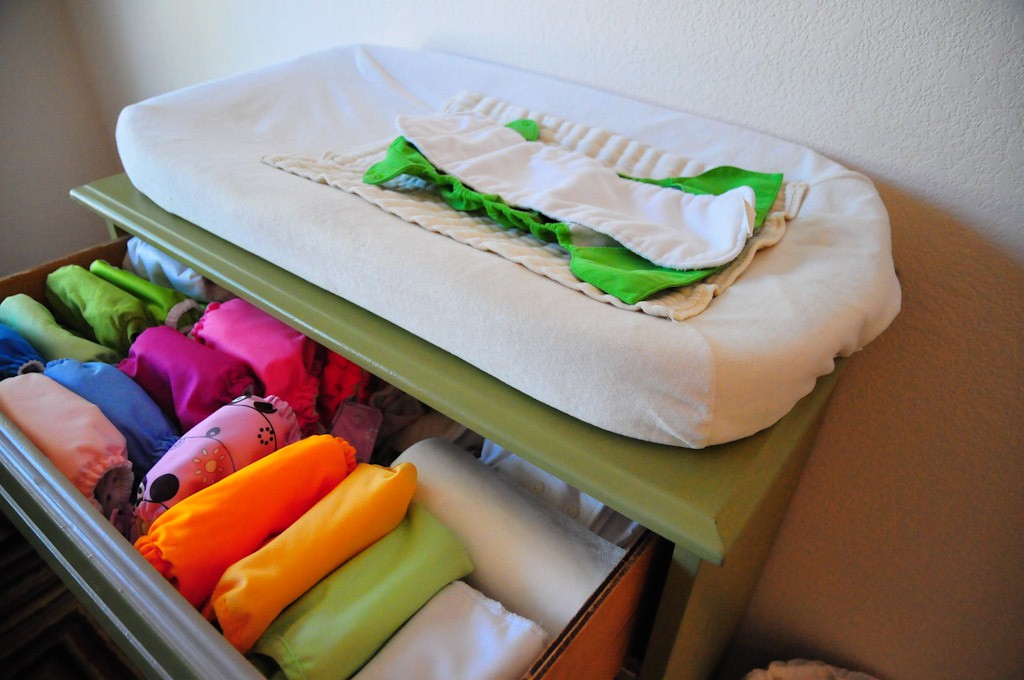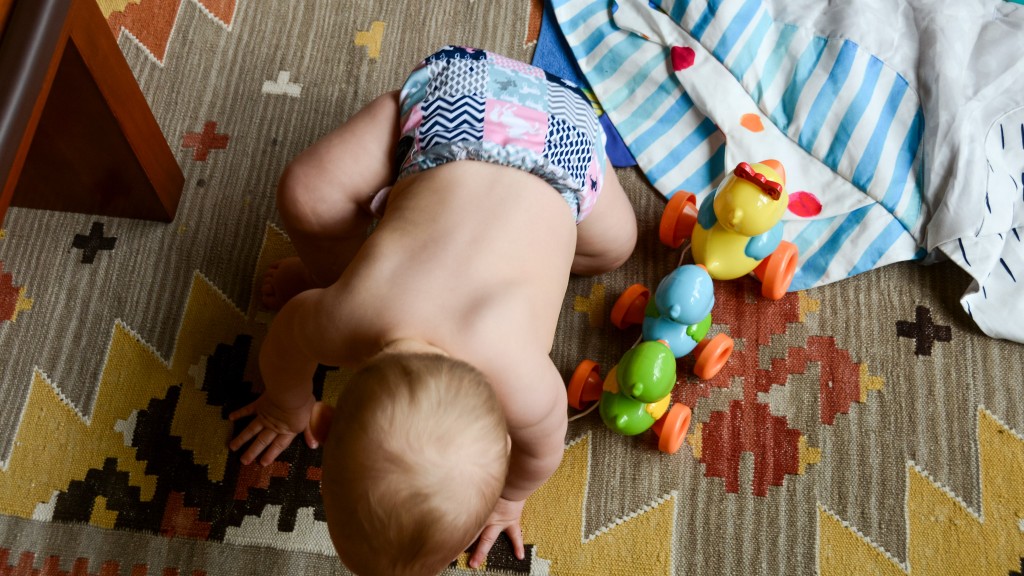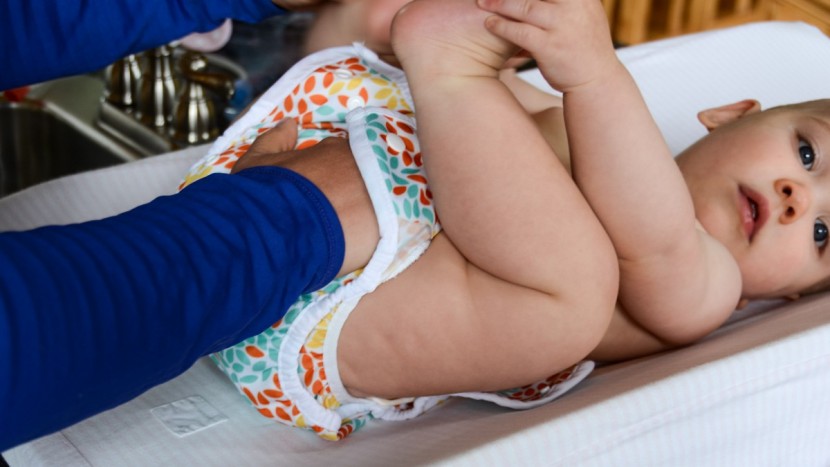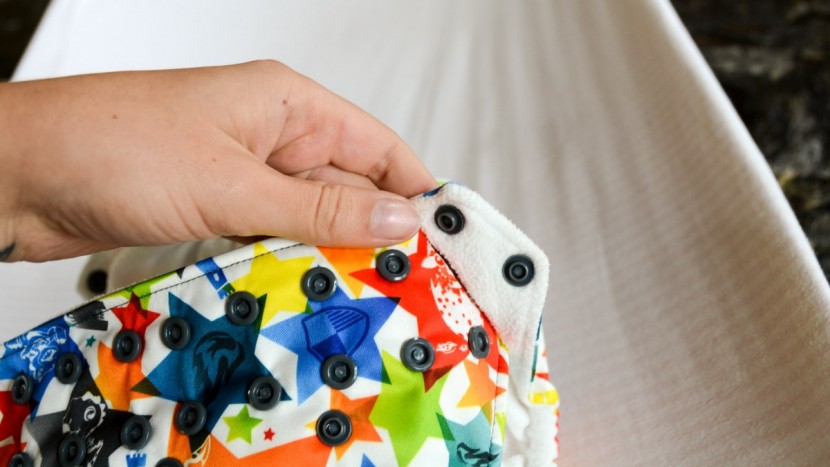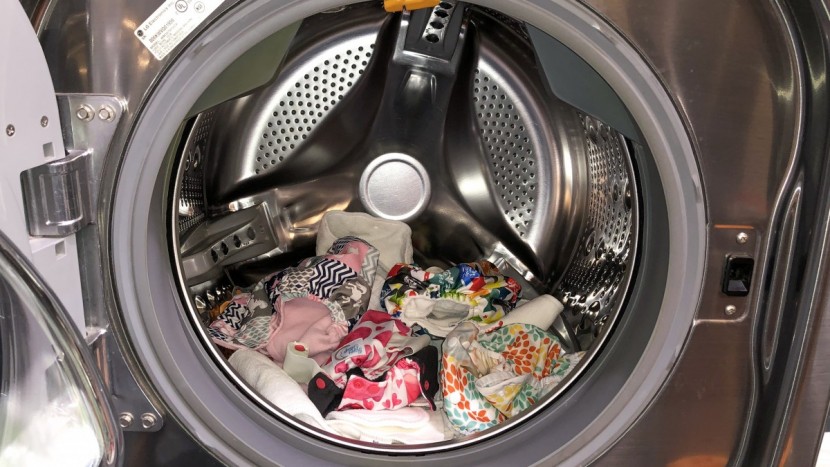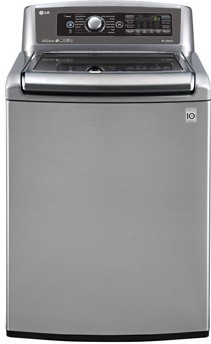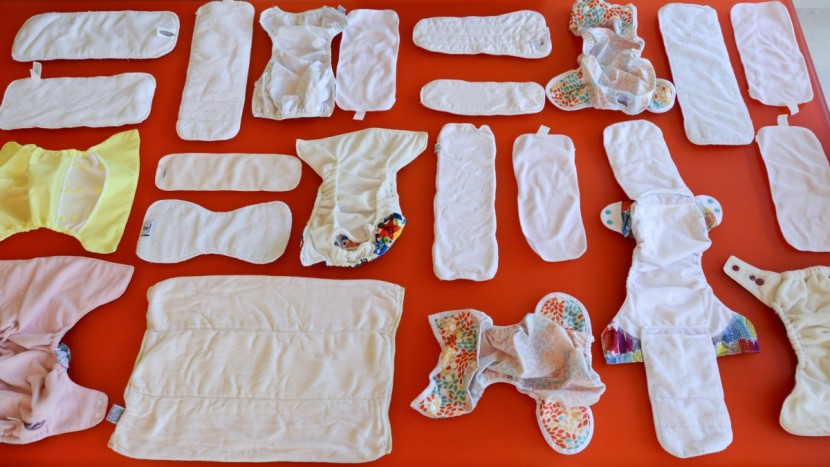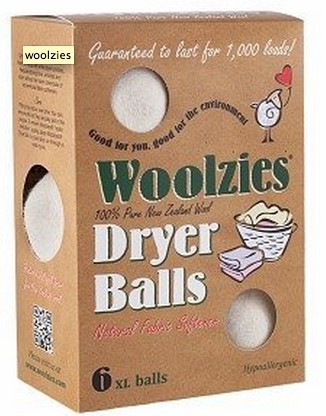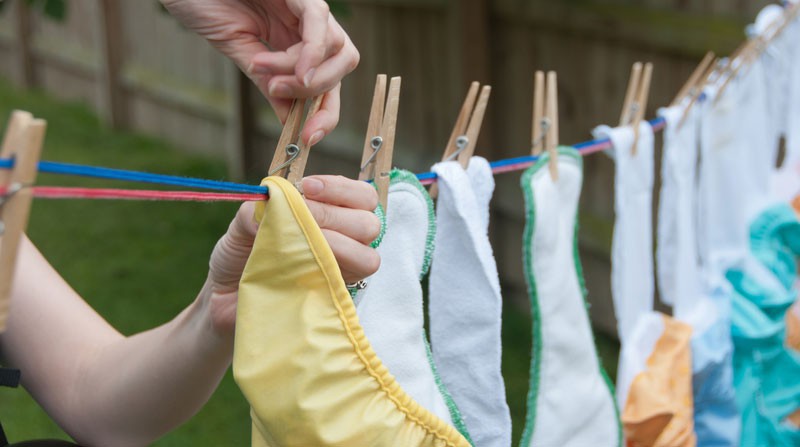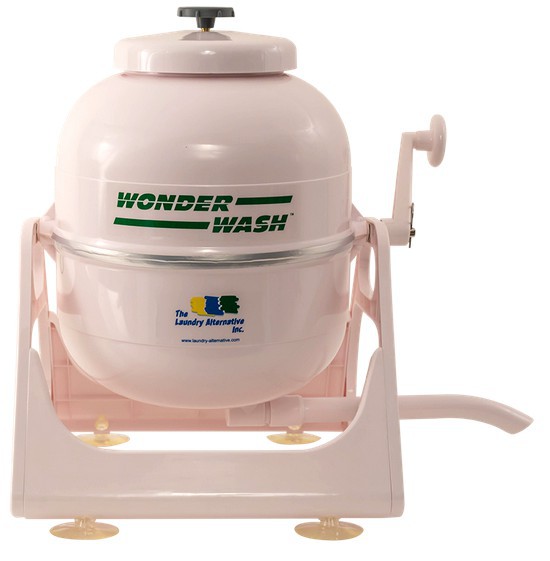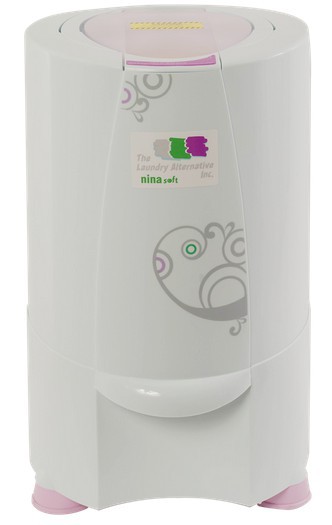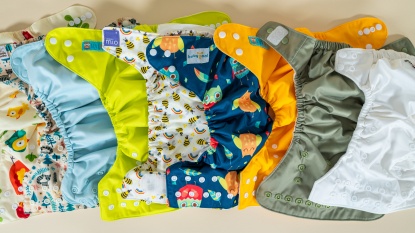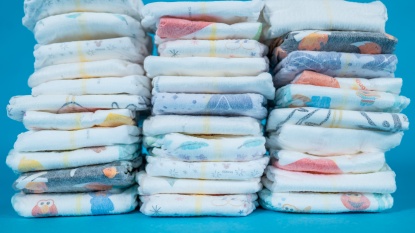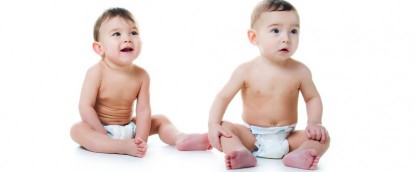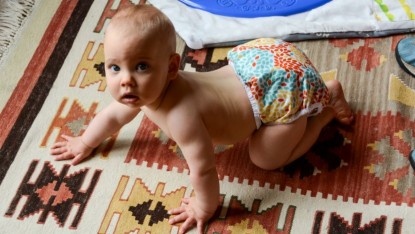This article is part of our comprehensive review of The Best Cloth Diapers. If you are on the fence about cloth, and just looking to educate yourself, take a look at our comparison of cloth and disposable diapers which gets down and dirty into the pros and cons of each style. We reviewed some of the top-performing diapers on the market and can give you some great recommendations.
If you have already made up your mind, and chose cloth, then congratulations! You're in the right place. This article will give you a collection of practical tips to make washing cloth diapers easier, as well as get the most absorbency and lifespan out of your investment. Proper laundering can help assure that your cloth diaper stash remains sanitary for baby's use with optimal performance.
Cloth Diapers Aren't Regular Laundry
A cloth diaper is going to be one of the dirtiest pieces of laundry in your household hands-down. As such, they require special care to get them clean and avoid ammonia build-up, odor retention, and diaper rashes.
Furthermore, cloth diapers require special attention due to their fabric makeup. Covers typically contain PUL and TPU laminates for waterproofing and stretchy elastic for comfort, neither of which hold up well in high heat or prolonged exposure to sunlight. They will have a central absorptive core often with a top wicking layer to keep baby dry. These fabrics vary and can include microfiber, cotton, bamboo, hemp, or various blends of each.
We will take you through the entire process. From prepping brand new diapers to changing baby to laundering, we cover it all.
Prepping Diapers
Before putting those new cloth diapers on your baby, it is important to pre-wash, or prep them for use according to the manufacturer's instructions. Typically, instructions for synthetic-based fabrics will differ from those that use natural fabrics.
- Natural Fibers — Hemp, bamboo, and natural cotton fibers all have oils that are naturally water repellent and can hinder absorbency. These diapers need to be washed and dried 3 to 6 times before their first use so some patience will be necessary. Multiple washes help rinse out the natural oils and achieve maximum absorbency. On this note, be sure to prewash natural fabrics separate to avoid natural oils getting into the synthetics.
- Synthetic Cloth Diapers — Mainly made up of microfiber, these only require one washing with detergent before their first use, so the process of getting started is much quicker. Although synthetic fabrics aren't typically as absorbent as natural fibers, they wick well and soak in urine quicker. They are generally better for babies with a fast and heavy stream.
Natural fibers and even some synthetics will increase in absorbency as they go through more washing and drying cycles.
Changing Baby
The process of changing baby is similar to that of disposables in that you remove the dirty diaper and clean baby's bum. However, this is where the similarity ends. Even when preparing a fresh cloth diaper, a few tricks and special products can help maintain the diaper's ability to function well throughout its lifetime.
- Cloth-Based Diaper Cream — Cloth-safe diaper creams do not contain petroleum or zinc. These ingredients can be extremely challenging to remove from cloth diapers and will guarantee problems with leakage. If baby needs a prescription or over the counter diaper cream containing either petroleum or zinc, be sure to use a thick, reusable liner to protect the fabric of the diaper.
- Liners — We will go into further detail about liners soon, but their function is relatively simple. They act as a barrier between diaper creams and cloth and make it easier to clean up poopy diapers.
While the disposable heads to the trash and subsequently, to the landfill, cloth diapers are laundered and re-used. But, before that cloth diaper heads to the washing machine, a few steps must be taken.
If you are using a disposable liner, lift it out of diaper with solids and throw into the toilet. If there are no solids, drop it in the trash. If any solids remain on the diaper, or if there is lots of urine (such as in an overnight diaper), you must remove it. You can do this either with some toilet paper or use a diaper sprayer to rinse it. After this, the cloth diaper can be placed in a dry pail to await laundering along with any other washable changing accouterments like cloth wipes and reusable liners.
Care for Closures
The way you care for the closures on your cloth diapers will make a big difference in how long they last. Though most cloth diapers are fairly hardy, they can only handle a certain amount of shearing force. Take care to be gentle when removing a diaper by unfastening snaps with two hands rather than ripping them off with one. This way, you can keep snaps from being accidentally removed as well as prevent tears in the fabric. After the diaper is off baby, you may want to consider closing the snaps before laundering. Loose snaps flying around in the washing machine and dryer have greater potential to break.
If your diapers have hook-and-loop closures, this step is even more crucial. Free velcro will stick to everything in the washing machine and create snags in the fabric of other diapers, ruining the inherent aesthetic cuteness of cloth diaper covers. Velcro also collects “stuff,” which will lessen its gripping strength and ultimately render it unusable.
Accessories
The following are extras that will make changing baby so much easier.
Liners
We recommend using liners to ease poop management. They will reduce the amount of clean up that is necessary as well as aid in minimizing stains and repelling issues. The only question is reusable or disposable?
Flushable Liners
Reusable Cloth Liners
Diaper Sprayer
If you are exclusively breastfeeding your baby, don't worry about rinsing the diaper. Breastfed stools will magically disintegrate and wash right away in the pre-rinse cycle. You will not see hide nor hair of them after this. Isn't that cool?! Unfortunately, this trick does not jive with formula or “solid” foods.
Spray Pal
Cloth Diaper Pail
When using an enclosed dry pail or bag, a handy tip is to consider either propping the lid open or leaving the zipper open a bit. Doing this allows for additional airflow as this will lessen ammonia build-up, and is especially relevant during the warm summer months.
Everyday Wash Routine
Laundry is possibly the biggest obstacle that cloth diaper users will encounter. There will be a lot of it, and you must use specific products and follow the correct process if you want your diapers to last. However, once you get into a good routine, it will become second nature.
When to Wash
Get your cloth diaper laundry done every two days if possible, three days max. If you wait any longer, urine-soaked diapers will lock in ammonia and microorganisms and then have a greater opportunity to grow. Eventually, this will lead to persistent issues with odor and the potential for diaper rash. Once ammonia and stink lock in, they are harder to remove. We highly recommend getting to know the website Fluff Love University, which has excellent common-sense advice. You will find information regarding not only cloth diaper laundering but every conceivable issue that you may come across in your journey.
Doing that Laundry
Laundering instructions vary among manufacturers. Following each can certainly maximize lifespan and absorbency, but if you have a mixture of brands, instructions will sometimes vary by quite a bit. In this case, it becomes necessary to streamline a wash routine for both sanity and practicality. Just make sure that there is enough laundry in each load to generate sufficient agitation to get the soiled cloth clean. Filling a machine's drum two-thirds to three-fourths works well (about 20-30 diapers for a standard-sized drum). If your dirty cloth diapers are short of this mark, we recommend adding dirty towels to the load. If you can set your machine to heavily soiled and high spin, this will help achieve the correct water and agitation levels to get the dirty stuff out. It will also help get the dirty water out of the drum.
To Extra Rinse or Not
There is conflicting information out there on whether to do one or two extra rinses after the main wash to further eliminate detergent residue.
The following is the Real Diaper Association's best practice Cloth Diaper Laundry Guide. It promotes the idea that before drying, you must ensure that all detergent residue is gone. That is, in the final rinse, there should be no lingering suds. Their cycle would go as follows:
- Rinse warm
- Wash hot with detergent (a longer cycle)
- Rinse warm twice
- Machine dry on low or line dry
However, Fluff Love University disagrees with these extra rinse cycles based on the idea that they unnecessarily introduce mineral deposits into the cloth. Minerals can wreak havoc by creating prime conditions for bacterial overgrowth and down the road possible problems with repelling and diaper rashes. They argue that if any residue is present after the main hot wash, then either the brand or amount of detergent should be changed.
Thus, it is ultimately up to you which technique works best in your household as there are several variables at play.
Water Type
The mineral content of water varies geographically, and this will make a difference in your laundry routine.
If you live in an area with hard water, it is typically more challenging to get cloth clean. Thus, more detergent is generally needed as well as a water softener such as Calgon. Extra rinses are discouraged so you can avoid mineral build-up. If you have soft water from your geographical location or via a water softener in your home, the converse is true. Soft water generally doesn't need as much detergent as hard water to get the dirty out of cloth diapers.
Cloth diapers should come out of the wash clean and fresh with no odor. If they smell of urine or poop, rewash them with more soap. If this doesn't work, consider trying a different brand of detergent.
Top-Loading Machines VS Front-Loading HE Machines
Top-loading machines and front-loading HE washing machines differ more than just in aesthetics.
Top-loading machines clean cloth diapers effectively because it is easy to adjust the amount of water in a load and the central axis agitates diapers thoroughly. However, increased physical agitation will put additional wear and tear on your diapers over time.
HE machines are great for water conservation and tend to more gentle on cloth diapers than top-loading machines. However, they may not agitate as well unless used properly. Though they may require a smaller amount of detergent for regular laundry, this isn't so for cloth diapering laundry because it is super dirty. HE Machines function best when the drum is 2/3rds to 3/4ths full, so this will mean anywhere between 20 to 30 cloth diapers, typically a few days worth of cloth diaper laundry.
The following is sound advice from Fluff Love University on how to use both types of washing machines properly for cloth diaper laundering:
Choosing a Detergent
Most cloth diaper manufacturers have loads of information on their websites detailing proper care for their brand. They include specific recommendations and usually lean more towards green, cloth-centric detergents. Is this a marketing ploy? Can conventional detergents be used with good results? The answer is yes.
Conventional Detergents
Conventional, synthetic-based detergents include Tide, Dreft, All, Arm & Hammer, Cheer, Purex, and Gain. They are usually less expensive than other green or cloth-centric detergents but tend to contain chemical ingredients such as:
- Fabric softener
- Fragrance
- Dyes
- Phosphates
- Optical or UV brighteners
- Whiteners
- Chlorine bleach
- Stain guards
- Wax
- Natural oils
Conventional “free and clear” while free of fragrances and dyes for those allergy and rash-prone typically contain at least some of the above chemical additives, and subsequently, aren't great for the environment.
Many cloth diaper manufacturers recommend cloth-based detergents because they do not contain fabric softener, which is a common cause of residue build-up. Residue can propagate bacterial and ammonia retention, the latter producing a particularly unpleasant eye-watering odor. So, avoiding fabric softener in detergent used for cloth diaper laundering sounds like a particularly good idea.
In terms of the synthetic chemical ingredients outlined above causing potential problems, we'd like to see some hard evidence to support this. There is a well-established history of cloth diapering parents using conventional detergents without issue.
However, one compelling reason for cloth diapering is to avoid synthetic chemicals coming into contact with baby's skin. Therefore, a good wash routine is necessary to ensure that detergent is entirely gone. If your budget allows, using a green, plant-based soap can further this effort.
Cloth Diaper Detergents
Cloth diaper-specific detergents are usually plant-based and greener because they do not contain as many synthetic chemicals. However, they are generally weaker than conventional detergents, and you will need to use more. Because of this, overall you will be spending more than you would on traditional detergents. What works best can be highly variable. As such, we'd like to direct you to the following helpful web articles based upon time-tested experience and direct user feedback.
- Washing Your Diapers in Plant-Based, Free and Clear Detergents
- Fluff Love University's Detergent Index
- Padded Tush Stats Detergent Statistics
- Best Performing Detergents For Washing Cloth Diapers.
Before drying, there should be very few lingering suds at the end of the wash cycle, if any. Unquestionably, your clean diapers should not feel sudsy. If so, consider reducing the amount of detergent used in small increments. Everyone's household will be different, so a bit of extra consideration, in the beginning, to figure out what works best for you will pay off. We also recommend paying special attention when using a new detergent for the first time.
Drying Strategy
Every brand of cloth diaper has specific drying instructions. Some recommend air-drying the cover but machine-drying the insert. Some allow the whole thing to be machine-dried, but usually on either low or medium heat. Once machine dried, let cloth diapers cool before stretching via folding or stuffing to maintain laminate and elastic integrity. Avoid drying cloth diapers on high heat as this will degrade components much quicker.
The following are a few useful accessories:
- Wool Dryer Balls — When drying cloth diapers in a machine, wool dryer balls can help reduce dry time by about 25%. They absorb moisture more quickly, saving time and minimizing wear and tear. They do not contain chemicals such as fabric softener, are hypoallergenic, and reduce wrinkling and static cling if thrown in with your regular laundry.
- Drying Line or Rack — Unless you have a convenient place built into your home, you are going to want to invest in an outdoor drying line or a drying rack. Having one of these near your washing machine is a handy way to air dry your cloth diapers.
Warranties
Many cloth diaper brands have warranties. However, they can be complex, and improper care can invalidate them. For instance, using bleach with Rumparooz will void your warranty. However, the Cotton Babies brands, bumGenius and Flip, recommend using 1/4 cup of bleach in the hot wash once a month to strip them of residue build-up. Other diaper manufacturers specify to steer clear of baking soda and vinegar. However, with BabyKicks Premium Pocket (which uses bamboo and hemp natural fibers), if odor becomes an issue, instructions are to wash the diaper with baking soda and vinegar until suds disappear. We recommend looking at manufacturer-specific washing instructions, as well as the warranty before you use either method. This way, you can be sure you are using the right approach for your diaper.
Shedding Stains & Odor
Get used to the idea that the interior of your baby's cloth diapers will never get back to that pristine, out-of-the-package white. Despite best washing practices, cloth diapers will eventually stain. However, there are some things you can do to minimize and reduce this.
Sunlight
For troublesome stains or persistent odor, dry cloth diapers out in the sun for a few hours when they are wet, after washing. The UV rays bleach out the stains and can help kill the odor-causing bacteria. However, proceed with caution, as UV light will take its toll on the elastic and waterproof lining. Particularly hot sun can even melt waterproof lining if diapers are left out too long. If its overcast or rainy, laying diapers in front of a window will even work some magic.
Machine Drying
Keep in mind that occasional machine drying (if allowed by the manufacturer) can help keep cloth diapers clean by killing bacteria build-up. Thirsties brand recommends machine drying even laminated covers once a month as this aids in the laminate's performance.
Troubleshooting
For problems with persistent odor retention, most manufacturers have specialized website instructions for addressing this. It seems that every brand has its tricks, all of which can vary widely. For instance, BabyKicks recommends a baking soda/vinegar regimen for when its hemp-based product gets stinky. Other brands don't do well with the vinegar or baking soda, so pay attention to these fine details among brands if special cleaning is needed.
Ammonia build-up can be tough to remove. We have found Rockin' Green's Funk Rock Ammonia Bouncer useful in both removing ammonia as well as for preventive use. We put it in the rinse cycle before washing to keep ammonia away.
If the situation isn't resolving, don't be shy about contacting the manufacturer directly to ask for help. Often, leading cloth diaper websites also have very well-vetted, helpful information. One such online retailer, Kelly's Closet, has the following article focused on getting rid of the stinkies.
The Skinny on “Stripping” Cloth Diapers
Stripping cloth diapers shouldn't be necessary if you use a proper cleaning regime as outlined above. However, despite your best efforts, this may need to be done once in a blue moon. It usually means that residue has accumulated typically from either hard water mineral deposits, bacterial build-up, or even diaper cream residue. The following are some scenarios where stripping may be necessary:
- Repeated washing in untreated hard water for over a month
- Second-hand cloth diapers receiving the above treatment
- Consistent repelling (a.k.a. leaking)
- Frequent use of fabric softener
- Ammonia smell is not resolving despite best washing efforts
- Persistent barnyard odor despite proper washing technique
- Diaper rash caused by staph, strep, yeast (includes ringworm)
- Baby has Clostridium difficile colitis (C. diff)
Each brand's website typically has detailed recommended instructions on how to strip their product. Again, this advice can vary widely by brand and site. Additionally, stripping should only be done on freshly washed diapers, they can be wet out of the machine but not dirty. We will refer you once again to Fluff Love University's stripping advice as it is both well-documented, clear, and well-vetted.
In general, stripping necessitates two separate SOAKING STEPS with a water-only washing cycle in between, followed by repetitive normal washing in hot water with detergent to rinse everything out:1) First Soak — A combination of hot water and mineral-removing solution, well dissolved such as RLR or GroVia Mighty Bubbles Laundry Treatment
2) Water Only Wash Cycle
3) Second Soak — 30 minute soak in cold chlorine bleach dilution. You can do this in a non-HE top-loading washing machine. If you don't have one, you must use a bathtub or smaller vessel. If so, make sure children do not have access.
4) Repetitive Washing Cycles — 2 to 4 normal washing cycles on hot with detergent to rinse everything out
If you are having issues with repelling due to some petroleum or zinc-based diaper cream inadvertently getting onto cloth diapers, have no fear. Try spot cleaning affected diapers in the sink with a small amount of original blue Dawn liquid soap. It is not a good idea to use Dawn in a washing machine (even a top-loader) as it can damage internal parts and cause an overzealous bubble situation.
No Easy Access to a Washer and Dryer?
Where there's a will, there's a way, and it doesn't have to be toilsome!
There are options for cleaning your cloth diapers even if you do not own a wash and dryer. Hobo Mamahas some great tips on using communal washer and dryers, along with some portable washer ideas. You can also check out Zany Zebra for some great information on handwashing your cloth diapers.Additional Resources For Cloth Diapering Success
- Fluff Love University — Clearly we are big fans of this website, and cannot recommend it enough.
- The Real Diaper Association — Laundry Science: Evidence-based cloth diaper washing
- The Eco Chic Blog — 10 Things You Should Never Do To Cloth Diapers Herein lie some cloth diapering words to live by.
- Grovia — GroVia's 6 mistakes when cloth diapering
Now get out there and enjoy your fluff!

